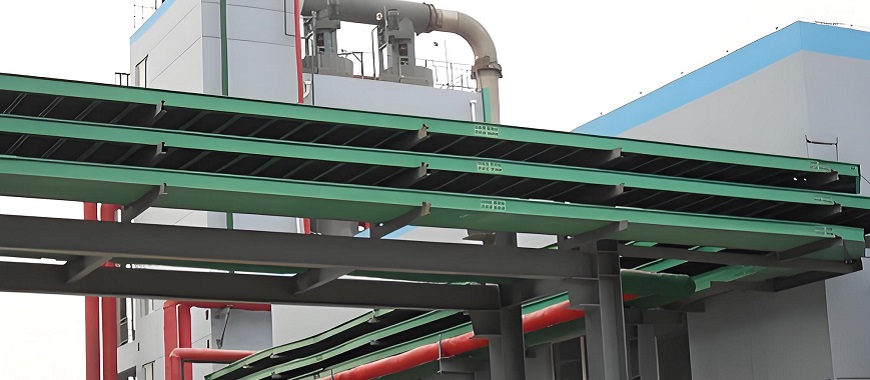
Cable tray and support systems are essential for managing and securing electrical and communication cables within various types of buildings and infrastructure. These systems provide a structured framework to support cables, ensuring they are organized, protected, and easily accessible for maintenance. In industrial, commercial, and residential installations, cable tray systems help in routing and supporting cables, making them crucial for both safety and efficiency.
By using cable trays, the risk of cable damage is minimized, and the overall safety of the installation is enhanced. These systems also allow for easy future upgrades and modifications without disrupting the entire setup. Cable tray and support systems are designed to meet the diverse needs of electrical professionals, ensuring that cables are securely held in place while being properly ventilated and protected from potential hazards.
Types of Cable Tray and Support Systems
Cable tray and support systems come in various forms to meet the needs of different installations. Below are some common types:
Ladder Cable Tray
- Description: Ladder cable trays are widely used for supporting a large number of electrical and telecommunications cables. They consist of two side rails connected by rungs, resembling a ladder structure.
- Benefits: This design allows for easy access, excellent air circulation, and reduced cable strain. The open design also makes it simple to inspect and maintain the cables.
- Common Uses: Ladder cable trays are often used in industrial environments where cables need to be securely supported without excessive weight or stress on the cables.
Enclosed Cable Tray
- Description: Enclosed cable trays are fully enclosed with solid sides and bottoms, providing complete protection for the cables inside.
- Benefits: These trays protect cables from debris, dust, moisture, and other environmental factors, ensuring a cleaner and safer installation environment.
- Applications: Enclosed cable trays are ideal for use in areas with harsher environmental conditions, such as chemical plants, or areas where cables need extra protection.
Wire Mesh Cable Tray
- Description: A wire mesh cable tray is made from steel wire mesh, offering a flexible solution for lightweight cable installations.
- Features: These trays provide excellent ventilation and flexibility, allowing easy installation and modifications.
- Benefits: Wire mesh cable trays are economical and easy to install. They are commonly used in commercial environments where cable management and airflow are priorities.
Cope Cable Tray
- Description: Cope cable trays are made up of interlocking components that allow for quick and easy assembly and customization.
- Benefits: Their modular design offers flexibility and adaptability, allowing for fast installation and future modifications.
- Applications: These trays are popular in both industrial and commercial environments for complex or changing cable installation needs.
The Role of Trinity Cable Tray in Modern Electrical Systems
Cable Tray and Support Systems: Support Typeses
Choosing the right support type is essential to ensure the stability and durability of cable tray and support systems. Here are some of the most common support types:
Universal Supports
- Description: Universal supports are adaptable and can be used with a variety of tray sizes and configurations. They provide flexibility in cable tray installation.
- Features: These supports are easy to adjust, durable, and can be mounted in various ways to suit different types of installations.
- Applications: Universal supports are frequently used in both industrial and commercial applications where flexibility is key.
Strut Supports
- Description: Strut supports are made of steel and are designed to support cable trays on elevated surfaces or in open spaces.
- Benefits: These supports offer excellent strength and stability, making them ideal for heavy-duty applications.
- Ideal Uses: Strut supports are common in large-scale industrial facilities or areas where maximum cable support is needed.
Beam Mount Brackets
- Description: Beam mount brackets are used to attach cable trays directly to beams or ceiling structures.
- Features: These brackets are adjustable to fit different beam sizes and provide strong, secure support for cable trays.
- Applications: Beam mount brackets are typically used in factories, warehouses, and other industrial settings where overhead installations are required.
Hold Down Clamps
- Description: Hold down clamps are designed to secure cables within the trays, preventing them from shifting or moving during installation or after setup.
- Benefits: They help ensure the cables remain organized, reducing the risk of damage and keeping the installation neat and stable.
- Ideal Uses: Hold down clamps are essential in high-vibration environments, such as manufacturing plants, where movement could potentially cause cable damage.
Comprehensive Guide to B Line Cable Tray Barrier Features
Cable Tray and Support Systems: Industrial Cable Tray Systems
Industrial cable tray and support systems are built to withstand harsh conditions while managing large volumes of cables. These systems are crucial in industrial settings where cable management is essential for safety and efficiency.
Heavy-Duty Cable Trays
- Description: Heavy-duty cable trays are designed for large-scale installations that require the support of high-capacity cables.
- Benefits: These trays are durable and can support large cables, making them ideal for electrical, telecommunication, and data systems.
- Features: Heavy-duty trays can be installed on walls, ceilings, or floors, with materials that can endure industrial environments, such as exposure to chemicals or extreme temperatures.
- Applications: These trays are commonly used in industrial plants, large commercial buildings, and manufacturing facilities where heavy-duty cable management is needed.
Material and Finish Options
- Description: Cable trays come in a variety of materials, such as steel, aluminum, and fiberglass, with several finish options like powder-coated or galvanized coatings.
- Benefits: Different materials are chosen based on environmental conditions like moisture, chemical exposure, or temperature extremes. For example, galvanized steel provides extra durability against corrosion.
- Applications: Choosing the right material ensures the cable tray system performs optimally and lasts longer in the environment it’s installed in.
Cable Tray and Support Systems: Cable Tray Electrical Applications
- Functionality:
- Cable tray and support systems serve a critical role in electrical installations by providing a safe and secure pathway for cables. These systems help organize and route electrical wiring, preventing tangles and damage. By keeping cables properly supported, cable trays ensure efficient cable management, reducing the likelihood of wear and tear during installation or future maintenance. Their design allows for easy access to cables, making future upgrades, repairs, or replacements simpler and less time-consuming.
- Standards Compliance:
- Cable tray systems must comply with various international standards, such as the National Electrical Code (NEC) and International Electrotechnical Commission (IEC) regulations, which ensure the safety, functionality, and reliability of the wiring system. These standards specify the appropriate sizing, materials, and installation methods for cable trays, ensuring that installations meet local and international safety requirements. Compliance with these regulations helps prevent potential electrical hazards, system failures, or regulatory violations.
- Electrical Safety:
- Safety is a top priority when installing electrical systems, and cable trays contribute significantly to minimizing electrical risks. For example, non-conductive fiberglass trays prevent accidental electrical conduction, reducing the risk of shocks or shorts. In installations requiring conductive trays, grounding is essential to safely channel electricity away in case of a fault. By using these grounded or non-conductive cable trays, the system safeguards both workers during installation and occupants after the installation, making it a key component in ensuring overall electrical safety in buildings.
By properly selecting and installing cable trays and support systems, you can enhance safety, meet compliance standards, and maintain the efficiency and organization of your electrical installations.
Tips for Calculating How Many Cables Fit in a Tray
Choosing the Right Cable Tray and Support System
Selecting the appropriate cable tray and support systems is crucial for ensuring a safe and effective installation. Here are some key factors to consider when making your choice:
Factors to Consider
- Load Capacity:
One of the most important considerations when selecting a cable tray system is its load capacity. The tray must be capable of supporting not only the weight of the cables currently being installed but also any additional cables that may be added in the future. Overloading the tray can lead to deformation, damage to the cables, or even system failure. When choosing a tray, ensure that it meets the specific weight requirements based on the type and quantity of cables, and consider potential future expansions to avoid the need for an upgrade later. - Tray Size and Dimensions:
Properly sizing the cable tray is critical to ensure it can accommodate the current and future needs of your installation. An undersized tray can cause cables to be squeezed, which can lead to cable damage, overheating, or increased difficulty in maintenance. When selecting the size, consider both the number of cables to be installed and the available space for future growth. Additionally, factors such as the installation angle, layout of the building, and complex cable runs must be taken into account. A well-sized cable tray will allow for easy access, prevent congestion, and provide sufficient airflow to avoid heat buildup, ensuring a safer and more efficient system. - Material Type and Durability:
The material of the cable tray plays a significant role in its performance and longevity. Common materials include galvanized steel, aluminum, fiberglass, and stainless steel, each offering unique benefits. Galvanized steel is durable and cost-effective but may be prone to corrosion in certain environments. Aluminum offers a lighter weight option with good corrosion resistance, making it ideal for outdoor installations. Fiberglass is non-conductive, resistant to corrosion, and lightweight, making it suitable for environments with high humidity or chemicals. Stainless steel provides excellent durability and resistance to harsh conditions, though it may come at a higher cost. When choosing the material, consider environmental factors such as exposure to moisture, chemicals, or temperature extremes. - Support System Compatibility:
A properly designed cable tray support system ensures stability and prevents strain on the tray and cables. It is crucial to choose a support system that matches the type and size of the tray. Fixed, adjustable, or suspension support systems each have their benefits and should be selected based on the installation’s complexity and the environmental factors. Adjustable supports are ideal for areas where future changes to the cable layout may be needed, while fixed supports provide long-term stability. Proper support ensures that the tray maintains its alignment, preventing sagging or misalignment that could cause damage to the cables. - Accessibility and Maintenance:
Installing cable trays with future maintenance in mind is essential for ensuring long-term system performance. Choose a tray design that provides easy access for routine inspection and maintenance. Systems with removable covers, hinged trays, or wide openings allow for straightforward access to cables when upgrades, additions, or repairs are needed. Planning for accessibility can help reduce downtime and minimize maintenance costs in the long run. - Compliance with Industry Standards:
Ensure that the chosen cable tray system complies with industry standards and regulations, such as the National Electrical Code (NEC) and Underwriters Laboratories (UL) guidelines. These standards help ensure the safety, functionality, and performance of the system. Compliance with these standards is especially important in environments with strict safety regulations or hazardous conditions. In addition to safety, adhering to industry standards ensures that the system is recognized and approved for use in commercial and industrial settings. - Environmental Considerations:
The environmental conditions where the cable tray will be installed are critical in selecting the appropriate materials and design. For instance, in areas with high humidity, corrosive chemicals, or extreme temperatures, you may need to select corrosion-resistant materials or weatherproofed systems. For outdoor installations, consider trays with UV protection or coatings to extend their lifespan and protect them from environmental degradation. For installations in high-risk areas, trays that offer fire resistance or those made from non-combustible materials should be prioritized.
By carefully evaluating these factors—load capacity, tray size, material choice, support system, maintenance accessibility, industry compliance, and environmental conditions—you can ensure that your cable tray installation is both safe and efficient. Proper planning and selection of the right system will not only improve the functionality of your wiring infrastructure but also extend its lifespan and reduce maintenance costs in the future.
FAQs about Cable Tray and Support Systems
Cable tray systems rely on various types of support to maintain their stability and functionality. The most common support types include universal supports, strut supports, beam mount brackets, and hold down clamps.
Universal Supports are versatile and can be adjusted to accommodate different tray sizes and configurations. They are durable and compatible with various mounting options, making them suitable for both industrial and commercial applications.
Strut Supports are heavy-duty supports made from steel, ideal for elevated installations. They provide excellent stability, especially in large-scale installations where additional strength is required.
Beam Mount Brackets are designed to attach cable trays directly to beams, ensuring secure overhead installations. These brackets are adjustable and can be used in factories or warehouses where high, secure support is necessary.
Hold Down Clamps are used to secure cables within the tray, preventing them from shifting. This is particularly important in environments with high vibration, such as manufacturing plants, where cable movement could lead to damage or disorganization.
Each support type plays a key role in ensuring the stability, safety, and longevity of cable tray systems in various settings.
The frequency with which a cable tray should be supported depends on several factors, including the size of the tray, the weight of the cables, and the installation environment. As a general rule, cable trays should be supported every 5 to 10 feet (1.5 to 3 meters) along their length. However, specific installation guidelines and codes, such as the National Electrical Code (NEC) or local building regulations, should always be followed to determine the exact support intervals for a given installation.
In certain environments where heavier cables or longer trays are used, additional support may be needed more frequently. For instance, industrial applications that involve heavy-duty cable trays carrying large cables might require more frequent supports to prevent sagging or stress on the tray. Additionally, environmental factors such as vibrations, temperature fluctuations, and exposure to moisture can also influence how often a tray should be supported.
Proper support ensures that the tray and cables remain secure, minimizing the risk of damage and ensuring the long-term functionality of the system.
Cable tray systems are structural frameworks designed to support and organize electrical cables and communication wires within buildings or industrial facilities. These systems are typically composed of trays, supports, and accessories that collectively allow cables to be routed, protected, and easily accessible for maintenance or future expansion. Cable trays come in various designs, including ladder trays, enclosed trays, wire mesh trays, and solid-bottom trays, each serving different needs based on the application and environment.
Cable tray systems help maintain the organization of wiring, which can improve safety by preventing tangling or accidental damage. They also promote efficient airflow around cables, reducing the risk of overheating. Moreover, cable tray systems simplify the installation of new cables or the replacement of existing ones without requiring extensive rewiring.
These systems are commonly used in industrial, commercial, and residential installations where reliable cable management is essential. By providing a structured and secure method for managing cables, cable tray systems help ensure the safety, reliability, and longevity of electrical systems.
A cable support system is a framework designed to securely support, suspend, or route cables and wires in various installation environments. These systems play a crucial role in maintaining the integrity of electrical and telecommunication systems by ensuring that cables are properly secured, organized, and protected from potential damage.
Cable support systems can include cable trays, cable ladders, cable raceways, brackets, clamps, and other accessories. The purpose of these systems is not only to support the weight of the cables but also to provide pathways for easy cable routing, promote ventilation, and allow for future cable additions or modifications. They are essential for reducing the risk of cables becoming damaged due to bending, vibration, or exposure to environmental factors.
In addition to cable trays, support systems may also involve specific hardware for mounting and securing cables to ceilings, walls, or other structural elements. Proper installation of a cable support system ensures compliance with safety standards and enhances the overall efficiency and longevity of electrical systems.

As the editor of GangLong Fiberglass, I have years of experience and in-depth research, focusing on cable tray products, fiberglass solutions, and grille systems. I incorporate years of industry insights and practical experience into every content, committed to promoting the progress of the industry. At GangLong Fiberglass, my commitment is reflected in every product, from innovative cable trays to durable fiberglass solutions and sturdy grille systems. As an authoritative voice in the industry, my goal is to provide valuable information to professionals and businesses and promote forward-looking solutions.


